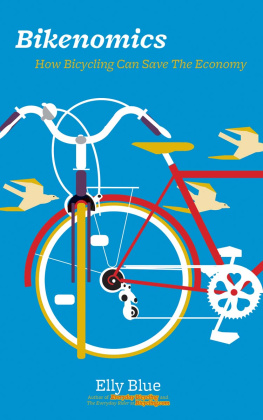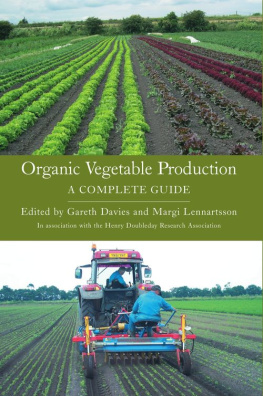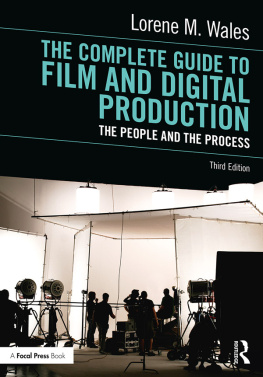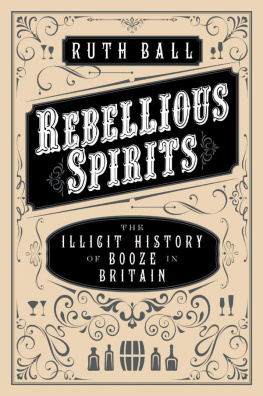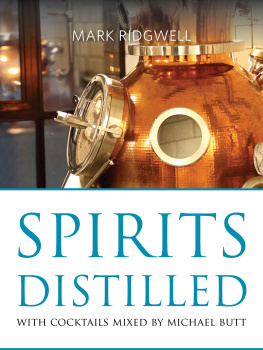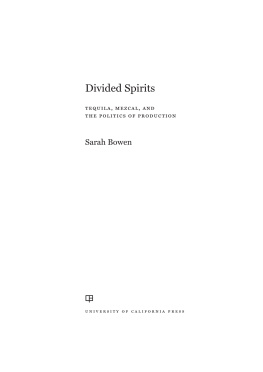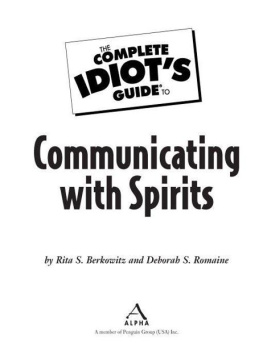Blue - The Complete Book of Spirits: a Guide to Their History, Production, and Enjoyment
Here you can read online Blue - The Complete Book of Spirits: a Guide to Their History, Production, and Enjoyment full text of the book (entire story) in english for free. Download pdf and epub, get meaning, cover and reviews about this ebook. City: New York, year: 2010;2004, publisher: HarperCollins e-books, genre: Home and family. Description of the work, (preface) as well as reviews are available. Best literature library LitArk.com created for fans of good reading and offers a wide selection of genres:
Romance novel
Science fiction
Adventure
Detective
Science
History
Home and family
Prose
Art
Politics
Computer
Non-fiction
Religion
Business
Children
Humor
Choose a favorite category and find really read worthwhile books. Enjoy immersion in the world of imagination, feel the emotions of the characters or learn something new for yourself, make an fascinating discovery.
- Book:The Complete Book of Spirits: a Guide to Their History, Production, and Enjoyment
- Author:
- Publisher:HarperCollins e-books
- Genre:
- Year:2010;2004
- City:New York
- Rating:5 / 5
- Favourites:Add to favourites
- Your mark:
- 100
- 1
- 2
- 3
- 4
- 5
The Complete Book of Spirits: a Guide to Their History, Production, and Enjoyment: summary, description and annotation
We offer to read an annotation, description, summary or preface (depends on what the author of the book "The Complete Book of Spirits: a Guide to Their History, Production, and Enjoyment" wrote himself). If you haven't found the necessary information about the book — write in the comments, we will try to find it.
Blue: author's other books
Who wrote The Complete Book of Spirits: a Guide to Their History, Production, and Enjoyment? Find out the surname, the name of the author of the book and a list of all author's works by series.
The Complete Book of Spirits: a Guide to Their History, Production, and Enjoyment — read online for free the complete book (whole text) full work
Below is the text of the book, divided by pages. System saving the place of the last page read, allows you to conveniently read the book "The Complete Book of Spirits: a Guide to Their History, Production, and Enjoyment" online for free, without having to search again every time where you left off. Put a bookmark, and you can go to the page where you finished reading at any time.
Font size:
Interval:
Bookmark:
This book is dedicated, with gratitude and admiration,
to the entire spirits industry, from the distillers to marketers,
merchants to bartenders, who have brought this category from
the ignominy of Prohibition and bathtub gin to the exquisite
golden age we are experiencing today.
A SPIRITUAL PURSUIT
I ts not by accident that distilled products are referred to as spirits, since they very much represent the essence of the substances from which theyre made. A great brandy captures the very spirit of the grapes from which it originated, just as a great whiskey captures the spirit of its original grain. In spirits, the humble products of the earthgrapes, corn, wheat, barley, potatoes, sugarcaneare transformed into rarefied quintessences.
The early alchemists who perfected the art of distillation in the Middle Ages were searching for ways to capture living spirits, extracting them from their raw materials. The techniques that have been handed down to us from these medieval practitioners have become considerably more commercialized, of course. But, at its heart, distillation even today retains a residual element of the inexplicable. Since the earliest days of distillation, the suggestion of a spiritual element has always been at play in the appreciation of spirits. It is this that makes spirits an endlessly fascinating pursuit and perhaps even a near-mystical experience.
And it should be clear that I am not talking about the abuse of spirits here. Spirits are adult pleasures and should be used with thought and moderation. As people in all parts of the world have learned over the course of thousands of years, spirits can provide humankind with relaxation, refreshment, and joy when used responsibly. Spirits can be used to promote conviviality, to cement friendships, to celebrate special occasions and rites of passage, and to aid in meditation and contemplation. We all ponder the meaning of life on occasion, but pondering the meaning of life over a glass of sublime cognac makes the task of philosophy less daunting and, I find, considerably more enlightening.
DISTILLATION AND ITS HISTORY
The process has changed very little over time. Distillation is actually quite a simple procedure, made possible by the differing boiling points of alcohol and water. Whereas water boils at 212 degrees Fahrenheit, alcohol boils at the lower temperature of 173. To separate alcohol from water, then, all that is required is to heat an alcoholic liquid (such as wine or beer) in a still to a temperature greater than 173 but less than 212 degrees. As the alcohol boils, its vapors rise to the top of the still, where they are collected and then cooled. Cooling returns the alcohol vapor to a condensed (liquid) state. The condensed liquid can be redistilled one or more times to increase the alcohol content of the end product.
A BRIEF HISTORY OF DISTILLATION
Distillation has been around since ancient times. Sea water can be rendered potable by distillation, wrote the Greek philosopher Aristotle. His discovery was allegedly based on the simple observation that steam from hot food condenses on the inner surface of the cover placed over the dish. Archaeological and historical research shows that the science of distillation was known to ancient Egyptian, Chinese, and Near Eastern societies.
Early civilizations learned how to create medicines, perfumes, and flavorings using simple distillation. Following the process, the resulting concentrated versions of herbs, spices, and plants were easy to use and store. The ancient Chinese created a unique spirit from rice and beer, and in the East Indies as long ago as 800 B.C . arrack was made with fermented sugarcane and rice.
Despite the long-standing awareness of the distillation effect, it was not until the early Middle Ages that the distillation of alcohol became a widespread practice and the modern history of this remarkable process began. The practice of distilling spirits was really instituted by Arab alchemists in the tenth century A.D . The very word alcohol is in fact an Arabic word, as is alambic, or still. For centuries the Arabs had been (and, in fact, still are) making eye makeup using black powder that was liquefied, vaporized, and solidified again. They called it kohl. When wine was first distilled, the name of this cosmetic was used to describe the result al kohl since the procedure was so similar. From the Arab masters, the knowledge of distillation was eventually passed to Western experimenters during the Middle Ages, who used it to create spirits.
In the Latin-speaking regions of medieval Europe, the newly discovered spirit was called aqua vitae (water of life). The reason for this rather grandiose name was the fact that, at first, distilled spirits were used mostly by alchemists, and many of these scientists thought that they had finally found the elusive elixir of life. In the thirteenth century, for example, the Majorcan chemist and philosopher Raymond Lully wrote that aqua vitae was an emanation of the divinity, an element newly revealed to men, but hid from antiquity, because the human race was then too young to need this beverage destined to revive the energies of modern decrepitude.
Wherever this knowledge of distillation spread, the Latin name was translated into the local language. In France it became known as eau-de-vie, while on the Irish peat bogs it was gaelicized into uisige beatha, which eventually was corrupted into the word whiskey. In Russia water of life evolved into vodka, from the Russian word for water, voda. In Denmark, Sweden, and Norway, the original Latin name took a Scandinavian turn to become aquavit.
Fifteenth-century Europe saw the popularity of distillation take hold and spread like wildfire. It was completely unregulated, and anyone who understood how the process worked could build a primitive still and produce his own aquavit. For raw materials these cottage distillers used whatever was inexpensive and in good, constant supply. In Ireland and Scotland whiskey got its distinctive character from barley and a dose of smoky peat. In France, Spain, and Italy wine was plentiful, and it formed the basis for locally made brandies. Barley, corn, and rye were the backbone of gin in Holland. Later, Caribbean sugarcane was made into rum and the Mexican agave, or century plant, was used in tequila. In Scandinavia the potato eventually became the spirits-making staple.
A CAVEAT
At this point I feel compelled to add the standard warning: Dont try this at home! First of all, as any backwoods moonshiner knows, distilling is strictly controlled by the federal government. Making your own backyard whiskey will draw the revenuers down on you like hawks on a chipmunk, leading to some very unpleasant consequences. Secondly, while the process of making alcohol is fairly simple, the process of making drinkable alcohol is a bit trickier. The first and last parts of the distillate (the so-called heads and tails) contain impure substances known as congeners. These include acids, esters, aldehydes, fusel oils, and salts. Some of these substances are desirable, giving each type of spirit its distinct tasteabsolutely pure alcohol would be characterlesswhile other congeners are undesirable or even poisonous. Master distillers know when and how to eliminate these impurities, winding up with alcohol that is not only potable but tasty. Making distinctive spirits also involves many postdistillation processes, such as flavoring (as in the case of gin), aging (as in the case of bourbon and Scotch), and filtration (as in the case of vodka). Unlike beer brewing and wine making, the making of spirits is something always to be left to professionals.
THE WORLD OF SPIRITS
There has never before been a greater wealth of spirits available to a wider base of consumers than there is today. Admittedly, many local or regional spirits have fallen by the wayside. This is particularly true of whiskeys, for example. After the vast consolidation and corporate assimilation that took place in the mid-and late-twentieth century, many once-revered Scotch and Irish distilleries are now silent or, worse, have been razed altogether. Its tempting to lament the days when there were some two thousand distilleries in Ireland alone, until one realizes that those myriad local whiskeys had very small distribution by todays standards. Today there are only three distilleries in Ireland, producing just a handful of whiskey brands, but thanks to globalization their products are available to a very wide and appreciative audience worldwide.
Font size:
Interval:
Bookmark:
Similar books «The Complete Book of Spirits: a Guide to Their History, Production, and Enjoyment»
Look at similar books to The Complete Book of Spirits: a Guide to Their History, Production, and Enjoyment. We have selected literature similar in name and meaning in the hope of providing readers with more options to find new, interesting, not yet read works.
Discussion, reviews of the book The Complete Book of Spirits: a Guide to Their History, Production, and Enjoyment and just readers' own opinions. Leave your comments, write what you think about the work, its meaning or the main characters. Specify what exactly you liked and what you didn't like, and why you think so.


